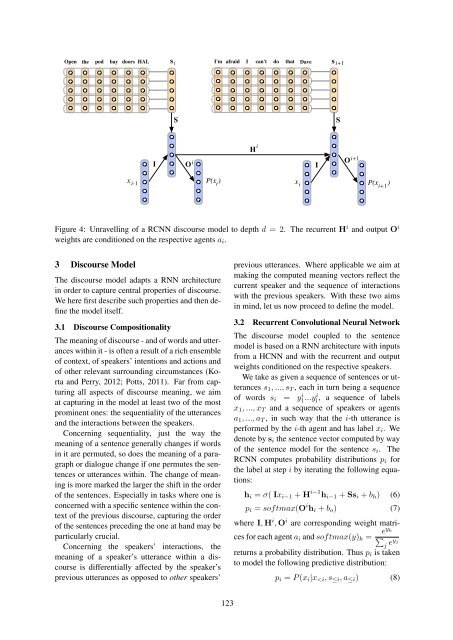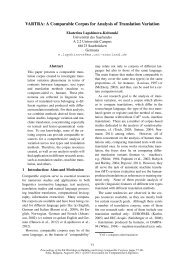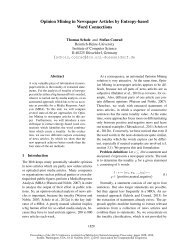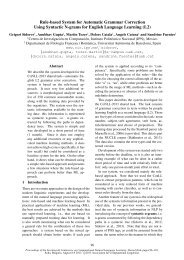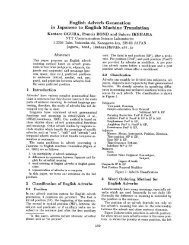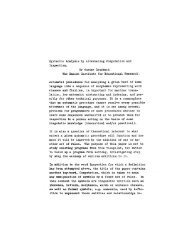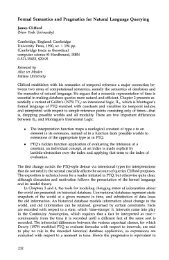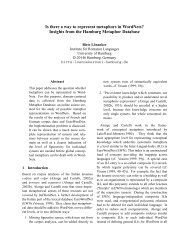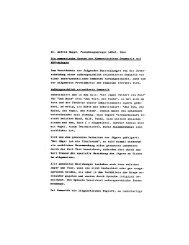Vector Space Semantic Parsing: A Framework for Compositional ...
Vector Space Semantic Parsing: A Framework for Compositional ...
Vector Space Semantic Parsing: A Framework for Compositional ...
Create successful ePaper yourself
Turn your PDF publications into a flip-book with our unique Google optimized e-Paper software.
s<br />
Open the pod bay doors HAL i I'm afraid I can't do that Dave s i+1<br />
S<br />
S<br />
I<br />
O<br />
i<br />
H<br />
i<br />
I<br />
O<br />
i+1<br />
x i-1<br />
P(x ) P(x )<br />
i<br />
x i<br />
i+1<br />
Figure 4: Unravelling of a RCNN discourse model to depth d = 2. The recurrent H i and output O i<br />
weights are conditioned on the respective agents a i .<br />
3 Discourse Model<br />
The discourse model adapts a RNN architecture<br />
in order to capture central properties of discourse.<br />
We here first describe such properties and then define<br />
the model itself.<br />
3.1 Discourse <strong>Compositional</strong>ity<br />
The meaning of discourse - and of words and utterances<br />
within it - is often a result of a rich ensemble<br />
of context, of speakers’ intentions and actions and<br />
of other relevant surrounding circumstances (Korta<br />
and Perry, 2012; Potts, 2011). Far from capturing<br />
all aspects of discourse meaning, we aim<br />
at capturing in the model at least two of the most<br />
prominent ones: the sequentiality of the utterances<br />
and the interactions between the speakers.<br />
Concerning sequentiality, just the way the<br />
meaning of a sentence generally changes if words<br />
in it are permuted, so does the meaning of a paragraph<br />
or dialogue change if one permutes the sentences<br />
or utterances within. The change of meaning<br />
is more marked the larger the shift in the order<br />
of the sentences. Especially in tasks where one is<br />
concerned with a specific sentence within the context<br />
of the previous discourse, capturing the order<br />
of the sentences preceding the one at hand may be<br />
particularly crucial.<br />
Concerning the speakers’ interactions, the<br />
meaning of a speaker’s utterance within a discourse<br />
is differentially affected by the speaker’s<br />
previous utterances as opposed to other speakers’<br />
previous utterances. Where applicable we aim at<br />
making the computed meaning vectors reflect the<br />
current speaker and the sequence of interactions<br />
with the previous speakers. With these two aims<br />
in mind, let us now proceed to define the model.<br />
3.2 Recurrent Convolutional Neural Network<br />
The discourse model coupled to the sentence<br />
model is based on a RNN architecture with inputs<br />
from a HCNN and with the recurrent and output<br />
weights conditioned on the respective speakers.<br />
We take as given a sequence of sentences or utterances<br />
s 1 , ..., s T , each in turn being a sequence<br />
of words s i = y1 i ...yi l<br />
, a sequence of labels<br />
x 1 , ..., x T and a sequence of speakers or agents<br />
a 1 , ..., a T , in such way that the i-th utterance is<br />
per<strong>for</strong>med by the i-th agent and has label x i . We<br />
denote by s i the sentence vector computed by way<br />
of the sentence model <strong>for</strong> the sentence s i . The<br />
RCNN computes probability distributions p i <strong>for</strong><br />
the label at step i by iterating the following equations:<br />
h i = σ( Ix i−1 + H i−1 h i−1 + Ss i + b h ) (6)<br />
p i = softmax(O i h i + b o ) (7)<br />
where I, H i , O i are corresponding weight matrices<br />
<strong>for</strong> each agent a i and softmax(y) k =<br />
ey k<br />
∑<br />
j ey j<br />
returns a probability distribution. Thus p i is taken<br />
to model the following predictive distribution:<br />
p i = P (x i |x


